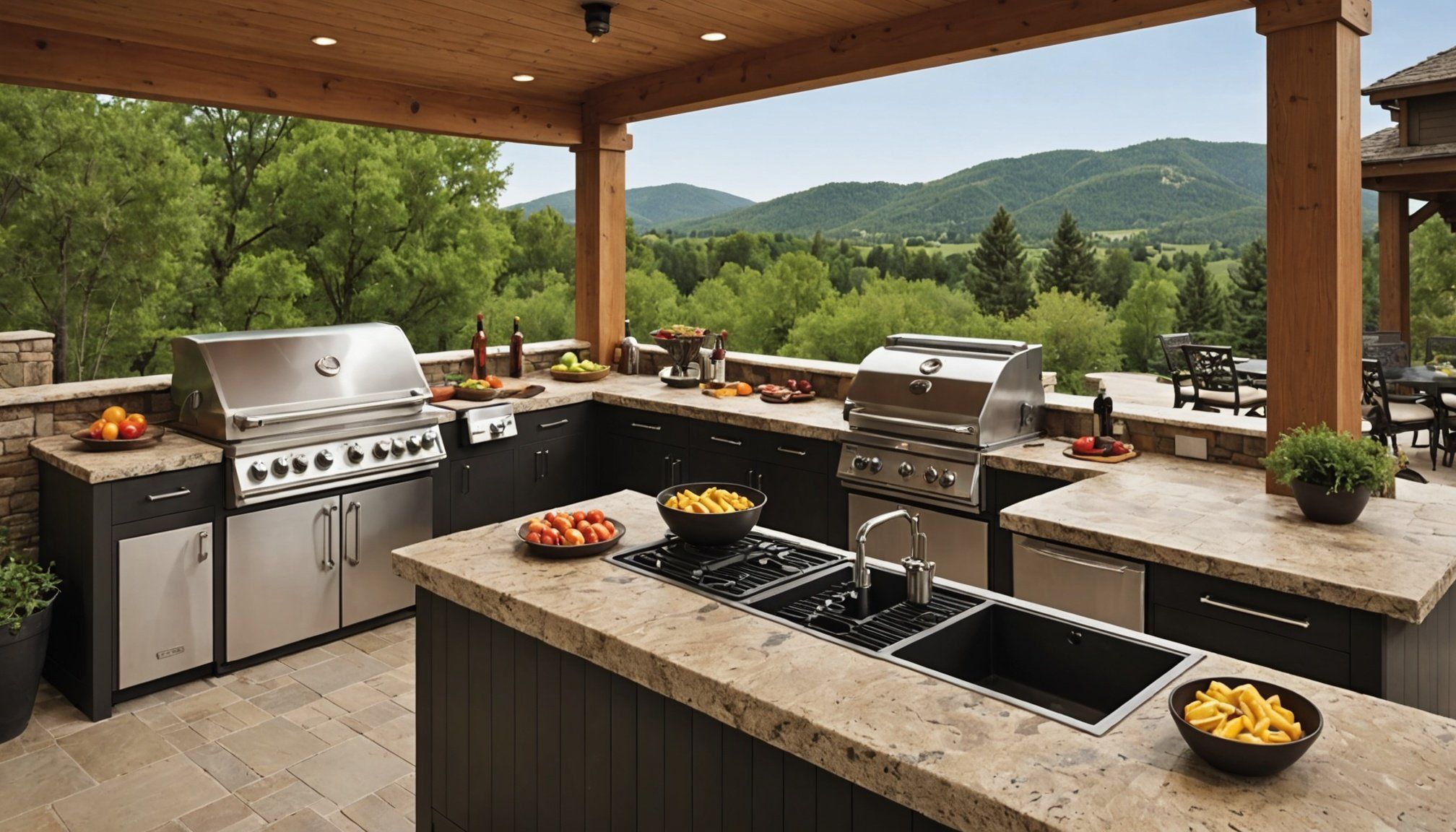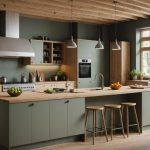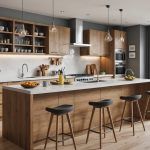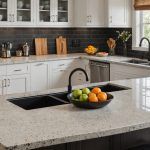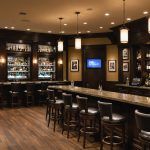Overview of Indoor-Outdoor Cooking Integration
The fusion of indoor-outdoor cooking spaces offers a multitude of advantages, revolutionising the culinary experience by combining convenience with the joy of alfresco dining. Integrating these spaces enhances not just functionality but also the aesthetic appeal of your home.
Benefits of Merging Indoor and Outdoor Cooking Areas
Bringing together indoor and outdoor cooking areas can transform mealtime into a multifaceted culinary experience. This integration provides homeowners the flexibility to entertain large gatherings by combining different cooking zones, making the transition between spaces seamless and enjoyable. It also amplifies the available space for meal preparation, enhancing social interaction during cooking activities.
In parallel : Creating an inclusive multi-sensory culinary journey for the visually impaired
Key Design Principles for Effective Integration
Key design principles emphasise strategic cooking space integration. This involves considering visibility and accessibility, ensuring that cooking elements and dining areas are well-connected and stress-free to navigate. Keeping an eye on ventilation and weather-proofing can also ensure optimal performance of cooking appliances in outdoor settings.
Common Challenges and Solutions
Combining indoor and outdoor spaces can present challenges like ensuring aesthetic continuity and managing climate variances. Solving these issues often involves selecting versatile materials that suit both environments. Weather-resistant furniture and appliances, as well as unified design elements, like colour schemes, can further aid in creating a cohesive, integrated cooking expeirence.
In parallel : Transforming your kitchen: creative strategies for an allergen-free and healthier home
Innovative Design Ideas
Innovative design ideas can be the key to achieving an immaculate balance between indoor and outdoor cooking spaces. With an emphasis on space planning and aesthetic harmony, these ideas bring creativity to life.
Open Concept Layouts
Open concept layouts excel in merging spaces into a cohesive whole. They eliminate barriers, providing a fluid transition that enhances the culinary experience. This design promotes visibility and interaction, making cooking and entertaining a unified affair.
Multi-functional Spaces
Designing multi-functional spaces ensures that every corner of your cooking area is utilised smartly. By incorporating islands and foldable furniture, these spaces can serve as prep stations, dining tables, or social hubs, maximising utility.
Outdoor Kitchen Essentials
Every outdoor kitchen should include essentials like a durable grill, weather-resistant counters, and suitable storage solutions. These features not only contribute to functionality but also to the seamless blend of indoor-outdoor harmony. They are integral elements in maintaining aesthetic harmony and efficiency.
Incorporating these design ideas can significantly impact the look and functionality of your cooking spaces, allowing you to delight in a versatile and cohesive cooking environment. Through strategic planning and creativity, your culinary ventures can be considerably enhanced.
Materials and Layout Tips
Selecting the right materials is crucial for creating a durable and visually appealing indoor-outdoor cooking space. Opt for weather-resistant materials like stainless steel and composite decking that can withstand environmental changes while maintaining aesthetic appeal. These materials not only provide longevity but also blend seamlessly with both indoor and outdoor elements.
Layout optimization plays a pivotal role in enhancing functionality and ensuring smooth traffic flow. To achieve this, consider placing the cooking workstation and appliances in easily accessible zones, allowing cooks and guests to move comfortably between indoor and outdoor areas. Position essential appliances like grills and stovetops where they complement each other, streamlining the culinary experience.
Integrating appliances and workstations seamlessly requires thoughtful planning. Ensure there is adequate space for cooking, preparation, and storage. Choose appliances that are suitable for both environments, focusing on functionality and ease of use.
Finally, successful design requires attention to functional design. This involves balancing utility with visual harmony, creating a cooking space that is as practical as it is beautiful. With the right materials and layout strategies, you can create a cooking space that fulfills both operational and aesthetic desires.
Successful Case Studies
Exploring real-life examples of integrated indoor-outdoor kitchens offers valuable design inspiration and insight into the transformative potential of these spaces. These projects often showcase inventive design approaches that merge indoor comforts with outdoor allure.
One standout project involved a family in Hampshire who successfully merged their cozy indoor kitchen with a lush garden setting. This transformation story highlighted the effectiveness of using retractable glass doors to blur boundaries, enhancing natural light and expanding views. The result was a seamless flow between spaces, enriching their culinary experience.
Lessons learned from these successful integration projects underscore the importance of space planning. A project in Devon demonstrated how careful planning can utilise unusually shaped outdoor areas effectively. By aligning cooking stations with natural pathways, they achieved both functionality and aesthetic harmony.
For those seeking visual inspiration, projects from Mediterranean-inspired designs to sleek urban layouts present diverse possibilities. One urban case study showcased how even small balconies can transition smoothly into the kitchen, creating a unique fusion.
These transformation stories exemplify how thoughtful integration of spaces boosts utility, appeals aesthetically, and enhances enjoyment in everyday culinary activities. They inspire homeowners to dream big when designing their own indoor-outdoor cooking sanctuaries.
Maintenance and Aesthetic Cohesion
Achieving aesthetic continuity and simplifying maintenance in an indoor-outdoor cooking space requires strategic planning. These spaces demand ongoing maintenance strategies to retain their visual appeal and functionality. One crucial aspect is addressing seasonal considerations. Outdoor kitchens must be designed to withstand environmental changes, meaning selecting durable, weather-resistant materials is vital. Properly sealing surfaces and using protective covers can help prolong their lifespan.
Maintaining a seamless look between indoor and outdoor areas also involves harmonising décor elements. Choose colour palettes and materials that naturally flow between the two spaces, creating a continuous visual theme. Use similar textures or complementary patterns to tie areas together, ensuring a unified aesthetic.
Outdoor upkeep is equally important to maintain a polished appearance. Regular cleaning and checking for wear are essential. Ensure appliances are resistant to outdoor conditions and are serviced routinely, preventing damage that might disrupt the harmonious design.
Combining these strategies ensures your cooking spaces remain both beautiful and functional year-round. By focusing on aesthetic continuity and implementing consistent maintenance strategies, you can create an inviting and durable culinary environment that stands the test of time.

